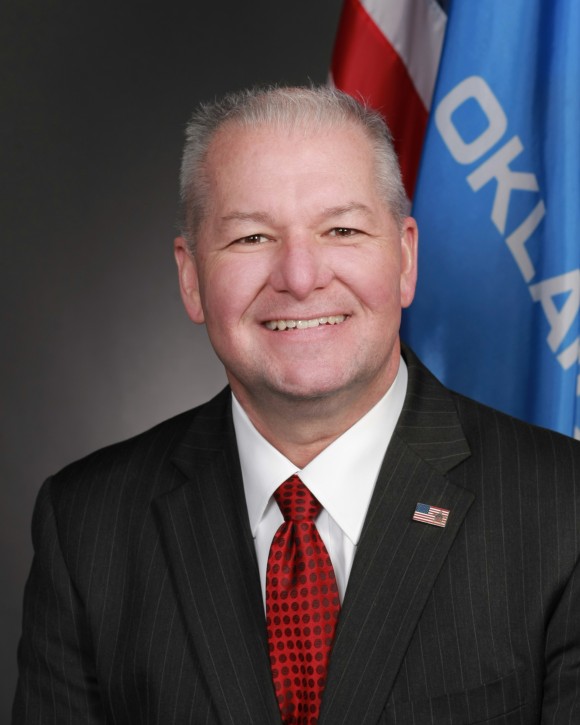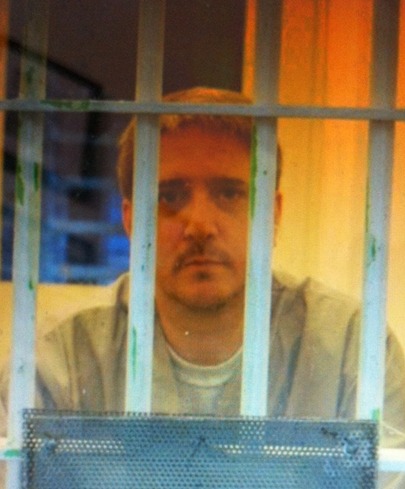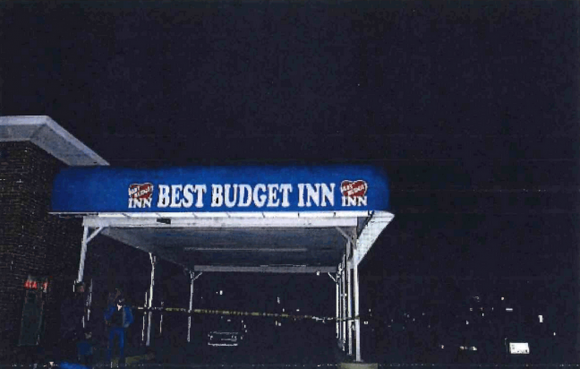aNewDomain — Attorneys for condemned accused killer Richard Glossip now accuse Oklahoma DA David Prater of Gestapo-like tactics to intimidate key defense witnesses, witnesses who claim that another man, not Glossip, was responsible for the killing of Oklahoma City hotel owner Barry Van Treese in 1997.
— Attorneys for condemned accused killer Richard Glossip now accuse Oklahoma DA David Prater of Gestapo-like tactics to intimidate key defense witnesses, witnesses who claim that another man, not Glossip, was responsible for the killing of Oklahoma City hotel owner Barry Van Treese in 1997.
Defense attorneys are mounting an aggressive 11th hour defense case to save the life of Glossip, who is scheduled to die by lethal injection next week. And they claim the state is doing everything it can to make sure the man they believe is the real killer isn’t brought to justice.
Glossip’s elite defense team recently moved to introduce newly discovered evidence of an affidavit from Michael Scott, who has sworn that he overheard convicted killer, Justin Sneed, saying that “he set Richard Glossip up, and that Richard Glossip didn’t do anything.”
And that’s in addition to testimony by Joshua Tapley, who said that Sneed, a cellmate in 1997, had offered him “very detailed accounts” about the murder. He even said, Tapley claims, how difficult Van Treese had been to murder. Tapley came forward when he heard Glossip was scheduled to die last week for the murder, a murder Tapley was sure the 19-year Oklahoma Death Row inmate didn’t commit. He was granted time to put together his defense, but now, time is running out.
Cops are rounding up and arresting defense witnesses. Why?
In a round up of defense witnesses by color of law, police arrested Scott at his home in Claremore on Tuesday — with guns drawn. Why? Cops were serving an arrest warrant in Rogers County for a $200 unpaid fine relating to a drunk driving and possession of marijuana arrest earlier this year.
 According to today’s court-filed papers, Glossip’s attorneys stated that District Attorney David Prater (left) had attempted to contact Scott, who declined to speak with Prater. Instead, Scott chose to limit his testimony to the proper place and time in court about his knowledge of facts surrounding Sneed’s remarks at Joseph Harp Correctional Center in 2006 about Glossip’s actual innocence.
According to today’s court-filed papers, Glossip’s attorneys stated that District Attorney David Prater (left) had attempted to contact Scott, who declined to speak with Prater. Instead, Scott chose to limit his testimony to the proper place and time in court about his knowledge of facts surrounding Sneed’s remarks at Joseph Harp Correctional Center in 2006 about Glossip’s actual innocence.
Scott has already suffered a smear campaign, conducted on September 19 in banner headlines. His photograph was plastered on the front page of The Daily Oklahoma after someone pulled a confidential record with Oklahoma Department of Corrections in an apparent attempt to disparage him and damage his credibility.
After police officers approached Scott’s mother at work inquiring about his whereabouts on Tuesday, they were directed to Scott’s residence in Claremore.
Several police officers surrounded his house and telephoned Scott to peacefully exit the residence through the back door to avoid embarrassment in front of his neighbors. As he exited the rear of the residence, he was confronted by several police officers with service weapons drawn and pointed at him.
Scott was handcuffed, told that some people needed to speak with him, and taken into custody at the station. Here District Attorney Prater and an investigator, Eastbrook, personally interrogated the handcuffed Scott about his drug use, including his own mother’s prescriptions.
This level of detail would only be known if someone entered his residence and found such prescriptions after he was driven away to the station.
According to the filing, “Prater specifically told (Scott) that he ordered this action so that Scott would be forced to talk with Prater and his investigator.”
Scott was not mirandized and felt pressured to cooperate during his interrogation, but volunteered only information consistent with his affidavit. He felt coerced during the interrogation to rescind his prior statement. Scott was eventually removed from the interrogation room to post bond in the underlying D.U.I. and marijuana possession offenses and was released.
At the same time police were trying to round up Scott, the state also issued an arrest warrant against Tapley, who was first to attest to Glossip’s innocence. and, through his attorney, indicated his refusal to speak with Prater.
The Office of the Oklahoma Attorney General has not returned phone calls concerning media inquiries about whether the actions of the Oklahoma District Attorney’s office warrant convening a county grand jury.
District Attorney Prater formerly served as the Director of Multi-County Grand Jury at the Office of the Oklahoma Attorney General years ago. That was before he assumed the elected position of Oklahoma County District Attorney in 2006, well after the two juries entered murder convictions against Glossip.
In Oklahoma, the consequences of witness tampering to prevent or attempt to prevent a witness from testifying or providing evidence to the court is a felony punishable by not less than one year, nor more than 10 years in prison.
Gaming the system
Behind this most recent disturbing backdrop the sands of time are quickly running out.
The rescheduled execution of Glossip, 52, is set for September 30, 2015. He has served 18 years on death row. Glossip was convicted of the first degree murder of Van Treese, who was bludgeoned to death with a baseball bat in Room 102 of the low-budget Best Budget Inn he owned in Oklahoma City.
Glossip had no prior criminal history and worked as a motel night manager at another establishment owned by Van Treese.
The killer, Justin Sneed, was employed as a hotel handyman in exchange for room and board.
The crux of the State’s case portrays Glossip as the mastermind of a contract murder, in which he manipulated or “counseled” Sneed to carry out the killing.
But according to Glossip’s attorney, Don Knight, Sneed has an established history of conniving, manipulating and committing theft to feed his methamphetamine addiction. Sneed has also admitted that he cut a deal with the State for leniency to avoid the death penalty in exchange for his testimony against Glossip.
At the trial, Sneed testified that Glossip offered him several thousand dollars on multiple occasions to kill Van Treese, all to conceal the fact that Glossip had failed to update the interiors of some of the motel rooms and that they would both be fired.
Sneed did not offer trial testimony in Glossip’s second trial in May and June of 2004.
Actual innocence turns on the facts of the case
At his first trial, the only evidence against Glossip was Sneed’s direct testimony, upon which the entire state’s case relied. No forensic evidence linked Glossip to the murder, nor was there evidence that showed any involvement of Glossip in planning or executing the murder. However, Glossip later admitted in the early stages of police investigation that he assisted Sneed in concealing the murder scene.
As a threshold matter on appeal, the Oklahoma Court of Criminal Appeals (OCCA) addressed the overarching issue of sufficient evidence of the state’s case based upon the questionable testimony of Sneed. Following an evidentiary hearing by the trial judge during the pendency of Glossip’s appeal to the OCCA, the state appellate court keenly observed in its published decision in Glossip v. State, 2001 OK CR 21 , 29 P.3d 597, 601, as follows:
The evidence at trial tending to corroborate Sneed’s testimony was extremely weak. We recognize that a conviction cannot be had upon the testimony of an accomplice unless it is ‘corroborated by such other evidence as tends to connect the defendant with the commission of the offense, and the corroboration is not sufficient if it merely shows the commission of the offense or the circumstances thereof.’”
 The OCCA further added the defense trial counsel, who has since been disbarred, was so ineffective “that no adversarial proceeding ever took place.” In 2004 the case returned to a jury, which also found Glossip guilty and upheld the death sentence.
The OCCA further added the defense trial counsel, who has since been disbarred, was so ineffective “that no adversarial proceeding ever took place.” In 2004 the case returned to a jury, which also found Glossip guilty and upheld the death sentence.
The record also shows that the jury was never allowed to view Sneed’s videotaped confession to Oklahoma City police detectives because the tape was never entered into evidence.
Following the OCCA’s remand for evidentiary hearing, the trial judge noted the glaring inconsistencies of Sneed’s statement to detectives and that the jury was never presented with impeachment evidence of Sneed’s inconsistent statements to his police interrogators, including Detective Beno.
Moreover, the state ordered Sneed’s psychological evaluation in 1997 by forensic psychologist Edith King (whose official report was also never entered into evidence).
She found that Sneed (pictured at right) had a violent juvenile history, a background of drug abuse and stood accused of killing Van Treese.
Additionally, King noted that Sneed was prescribed lithium as a mood stabilizer for his meth addiction to help him to control his violent outbursts.
Dr. King’s report corroborates a newly-furnished affidavit from Richard Barrett, a meth dealer who identified Sneed as an addict who purchased the drug from him or Bobby Glossip, Glossip’s brother, on several occasions in Room 102 at the motel.
At trial, Dr. King’s competency report could have been used to impeach Sneed, but the trial court found the report was inadmissible hearsay because Sneed was incompetent — the court claimed he could not recollect events due to diminished capacity and meth-induced brain damage.
Subsequent federal appellate review found that exclusion of the competency report was a harmless error and merely demonstrated that Sneed was financially dependent upon Glossip for room and board and elaborated on Sneed’s juvenile record, involving burglary, bomb threats, violence at school and drug abuse.
On police-induced interrogations … and potentially false confessions
The most glaring discrepancy between Sneed’s videotaped confession and trial testimony occurred when Sneed revealed that Glossip told him “to pick up some trash bags, a hack saw and I believe some muriatic acid. He was wanting to pour the acid upon the body and then saw up the rest of the body and put it in trash bags to be able to move it out of the room.” Sneed never mentioned this account in his videotaped confession.
 The OCCA found that defense counsel cross-examined Sneed and Detective Beno at trial about the circumstances of the police-induced interrogation — that bulky and gruff Detective Beno repeatedly badgered the slightly-built Sneed; that Detective Beno knew Glossip had masterminded the homicide, overcoming Sneed’s initial denial that Glossip was not involved in the homicide.
The OCCA found that defense counsel cross-examined Sneed and Detective Beno at trial about the circumstances of the police-induced interrogation — that bulky and gruff Detective Beno repeatedly badgered the slightly-built Sneed; that Detective Beno knew Glossip had masterminded the homicide, overcoming Sneed’s initial denial that Glossip was not involved in the homicide.
In this vein, the OCCA observed that the videotape would have shown “the jury how clearly and unambiguously the detectives telegraphed to (Sneed) that they wanted him to inculpate (Glossip).”
The competency report of Sneed plainly showed his diminished capacity and susceptibility to police-induced coercion.
Ironically, the state used this same theme of Sneed’s diminished capacity to instead characterize Glossip as the consummate manipulator ordering the malleable, dependent Sneed as a buffer to carry out the homicide.
A call for prosecutorial accountability
In the thousands of cases nationwide that never receive serious post-conviction litigation, this successful prosecutorial strategy of police coercion, which knowingly encourages perjury, wholly denies defendants’ rights to fully confront the witnesses against them. It represents a systemic massive abuse of the system. The Glossip case provides a glaring example that this kind of corruption is an everyday fact of the criminal justice system in America.
In short, Glossip’s first trial was a complete wash due to:
- Ineffectiveness of counsel to raise issues about a police-coerced confession of a jailhouse snitch.
- Sneed’s inconsistent statements and grandiose trial testimony of a conspiratorial professional “hit” of the decedent.
- The jury’s reliance upon Sneed’s incompetent testimony, upon which the entire state’s case relied, without any corroboration.
Years later, the second trial court allowed limited examination of Sneed about the circumstances of his interrogation, but again excluded an opportunity for the jury to view the videotaped interrogation of Sneed. As such they would have seen the suggestive techniques used by Detective Beno to sway Sneed.
Given the international media attention and legal significance of this bellweather case, it’s interesting to note the demeaning swagger of the Oklahoma County District Attorney, David Prater, writing off the defense position and national media coverage as “a bullshit public relations campaign.”
However, it has been shown nationwide with increasing clarity that the power of journalism may serve to achieve prosecutorial accountability, exposing the corruption surrounding the use of snitch/informant testimony.
The recent arrest of affiant Scott, who highlights the credibility of the state’s sole witness (Sneed), clearly demonstrates a pattern and practice of intolerable official misconduct. Using witness tampering to shut down the defense in possibly the final days of Glossip’s life, where the District Attorney plays judge, jury and executioner is hard to stomach.
Spoliation of evidence, willful or negligent destruction of evidence
Another major issue of trial court error in both trials involves the absence of an instruction to the jury about “spoliation” or destruction of evidence going toward Glossip’s innocence. The box of physical evidence in the Sneed-Glossip case was initially maintained at the residence of later discredited police chemist, Joyce Gilchrist, and supervisor of the DNA lab, who was found to misidentify evidence at numerous other murder trials. Gilchrist was infamous for tailoring her testimony to fit the state’s case like a glove, which resulted in overturning scores of murder cases. In 2004 the police inexplicably disposed of the contents of the box only days prior to Glossip’s second trial.
According to a recently disclosed 1999 police report, the inventory of the destroyed evidence included a bag of duct tape, which would have supported the defense theory that the homicide resulted from a burglary gone awry.
The inventory implies that Sneed had only intended to subdue, restrain and muzzle his victim with the duct tape to steal money — at least until Van Treese put up a real fight and went down swinging in the ensuing struggle.
A federal court pursuant to the Antiterrorism and Effective Death Penalty Act of 1996 (AEDPA) may find such official misconduct as requiring a jury instruction to inform the jury of a negative inference against the state’s case due to its own intentional or negligent official destruction of evidence.
Constitutionality of Oklahoma’s lethal cocktail
This June, in an explosive and heavily-divided opinion, the U.S. Supreme Court rejected Glossip’s Eighth Amendment claim that Oklahoma’s means of lethal-injection execution using midazolam would render a virtual certainty that an inmate would feel pain due to the compound’s failure to induce deep sedation.
However, the Connecticut Supreme Court in August found the state’s imposition of the death penalty as unconstitutional based upon the compelling dissent by Justice Stephen Bryer in the Glossip appeal.
Given the OCCA’s brief reprieve earlier this month to allow consideration of newly-provided evidence, Glossip’s defense team is racing against the clock to salvage the legal mess made of a fairly straightforward case doomed due to ineffective assistance of defense counsel of the condemned inmate.
For aNewDomain, I’m Jim Kelly.
Images in order: Richard Glossip courtesy richardglossip.com; David Prater via ok.gov; Justin Sneed and Best Budget Inn screenshots courtesy ReadFrontier












